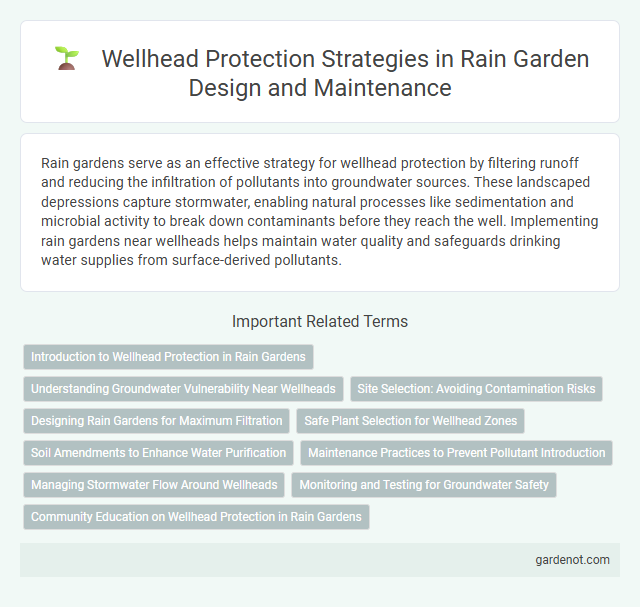Rain gardens serve as an effective strategy for wellhead protection by filtering runoff and reducing the infiltration of pollutants into groundwater sources. These landscaped depressions capture stormwater, enabling natural processes like sedimentation and microbial activity to break down contaminants before they reach the well. Implementing rain gardens near wellheads helps maintain water quality and safeguards drinking water supplies from surface-derived pollutants.
Introduction to Wellhead Protection in Rain Gardens
Wellhead protection in rain gardens involves designing and maintaining infiltration areas to prevent contaminants from entering groundwater supplies near water wells. Implementing proper vegetation, soil filtration layers, and setback distances enhances the natural treatment of stormwater while safeguarding aquifers. Effective wellhead protection reduces the risk of pollution, ensuring clean and safe drinking water through natural filtration processes.
Understanding Groundwater Vulnerability Near Wellheads
Groundwater vulnerability near wellheads is critical for wellhead protection as contaminants can rapidly infiltrate and compromise water quality. Identifying soil permeability, depth to groundwater, and land use around wellheads helps assess potential risks from surface pollutants. Implementing rain gardens in these areas aids in filtering runoff, reducing contaminant transport, and preserving aquifer integrity.
Site Selection: Avoiding Contamination Risks
Selecting a rain garden site near a wellhead demands careful assessment to prevent contamination risks; maintaining a minimum setback distance is crucial to protect groundwater quality. Avoiding locations downhill of potential pollution sources like septic systems, agricultural runoff, or industrial sites reduces threats to drinking water safety. Proper site evaluation with soil permeability and hydrological studies ensures effective filtration without compromising wellhead protection zones.
Designing Rain Gardens for Maximum Filtration
Designing rain gardens with wellhead protection involves strategically sizing and locating the garden to maximize infiltration while preventing contamination. Using layers of sand, compost, and native plants enhances filtration by promoting natural breakdown of pollutants before groundwater recharge. Proper design ensures that rain gardens act as effective barriers, preserving the safety of drinking water sources near wellheads.
Safe Plant Selection for Wellhead Zones
Selecting native, deep-rooted plants with minimal fertilizer and pesticide needs is essential for wellhead protection in rain gardens, as these species reduce the risk of groundwater contamination. Avoiding invasive or shallow-rooted plants helps maintain soil stability and prevents pollutants from seeping into the aquifer. Proper plant selection ensures effective filtration of stormwater while safeguarding the integrity of the wellhead zone.
Soil Amendments to Enhance Water Purification
Soil amendments in rain gardens play a crucial role in wellhead protection by enhancing water purification through improved filtration and pollutant breakdown. Incorporating biochar, compost, and sand increases soil permeability and boosts microbial activity, effectively reducing contaminants like nitrates and heavy metals before water infiltrates groundwater supplies. These tailored soil mixtures help maintain high water quality around wellheads, safeguarding drinking water sources from surface pollutants.
Maintenance Practices to Prevent Pollutant Introduction
Effective maintenance practices for rain garden wellhead protection include regular inspection to identify and remove debris, sediment, and invasive plants that can introduce pollutants. Avoiding the use of chemical fertilizers, pesticides, and herbicides near the rain garden minimizes contamination risks to groundwater sources. Ensuring proper vegetative cover and using native plants supports filtration, reduces erosion, and enhances pollutant breakdown, safeguarding wellhead water quality.
Managing Stormwater Flow Around Wellheads
Managing stormwater flow around wellheads is critical for wellhead protection and preventing groundwater contamination. Rain gardens strategically capture and infiltrate runoff, reducing pollutant loads and minimizing surface water infiltration directly over the wellhead area. Proper design and placement of rain gardens ensure effective diversion of stormwater, safeguarding the integrity of drinking water sources.
Monitoring and Testing for Groundwater Safety
Regular monitoring and testing of groundwater around wellheads in rain gardens is critical for ensuring water safety and preventing contamination. Implementing advanced sensor technology and conducting periodic water quality assessments help detect pollutants and maintain compliance with environmental regulations. Data collected supports adaptive management strategies that protect drinking water sources and promote sustainable groundwater use.
Community Education on Wellhead Protection in Rain Gardens
Community education on wellhead protection within rain gardens emphasizes the importance of preventing contaminants from infiltrating groundwater sources. Educational programs highlight best practices such as proper disposal of hazardous materials and the use of native plants to enhance filtration. Engaging local residents fosters stewardship, ultimately supporting cleaner water supplies and sustainable urban ecosystems.
Wellhead protection Infographic

 gardenot.com
gardenot.com